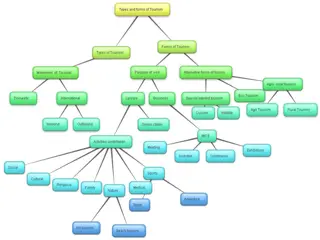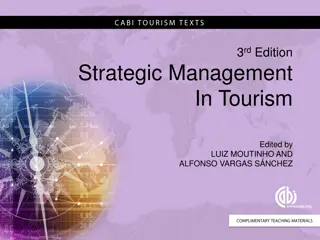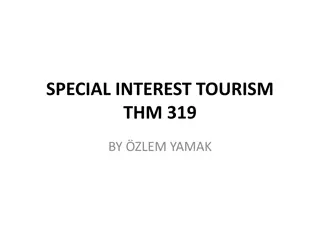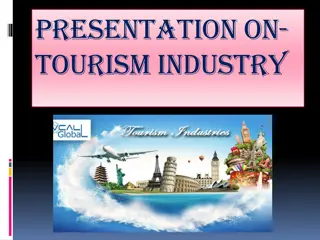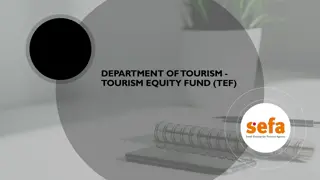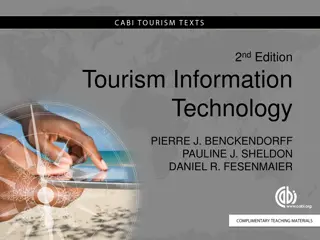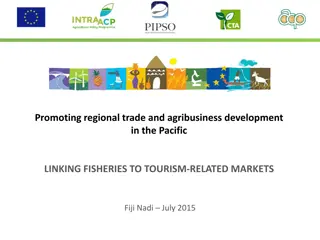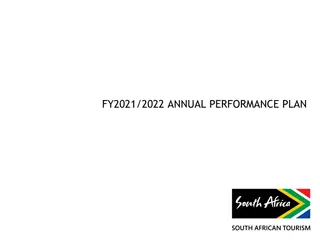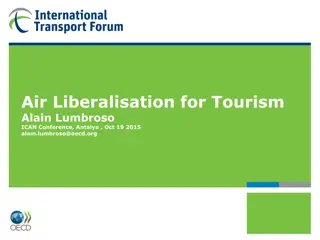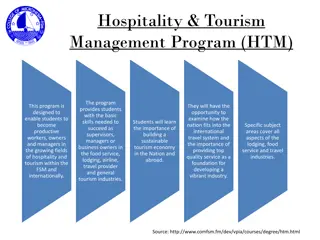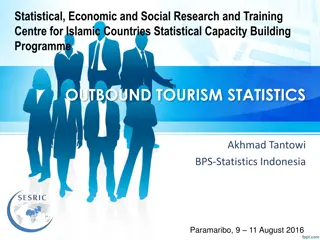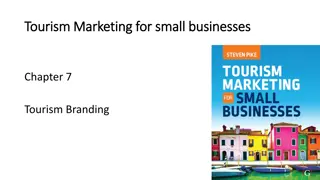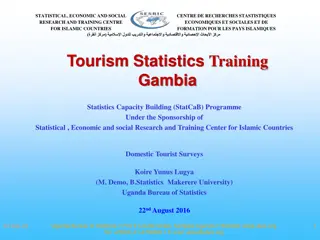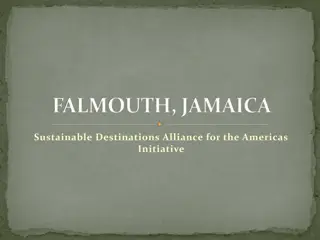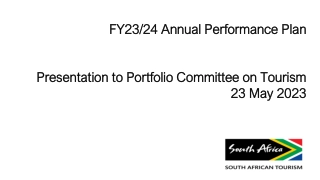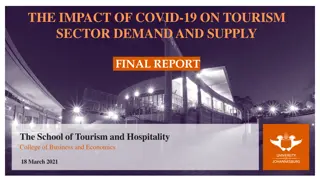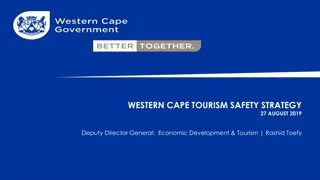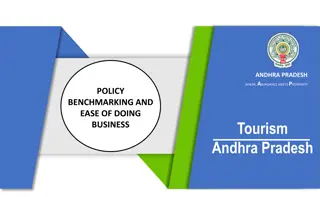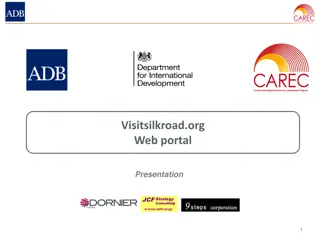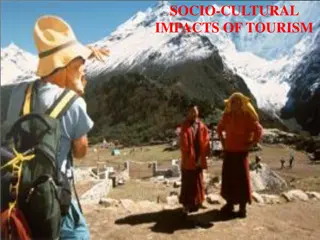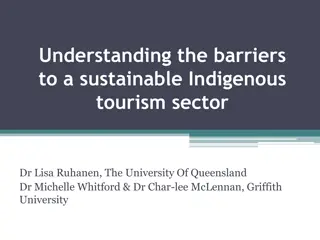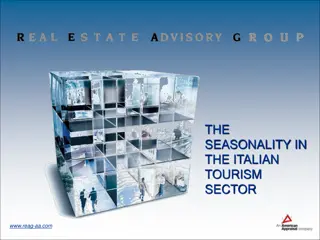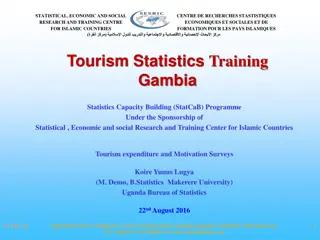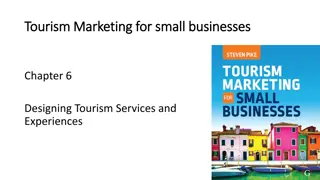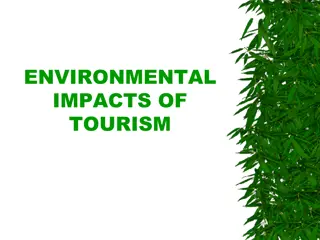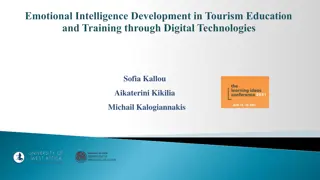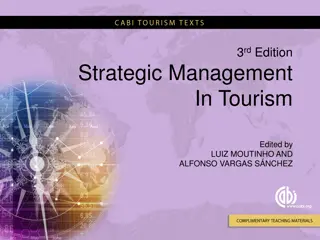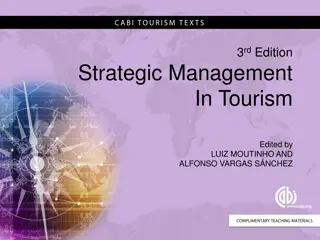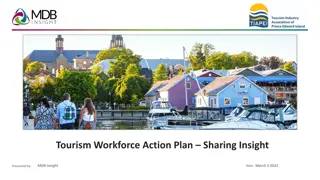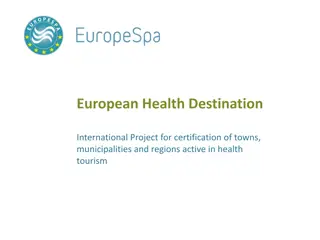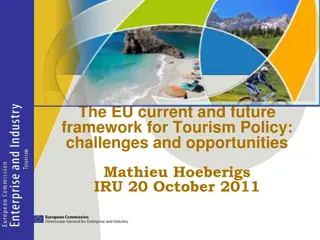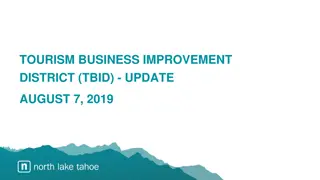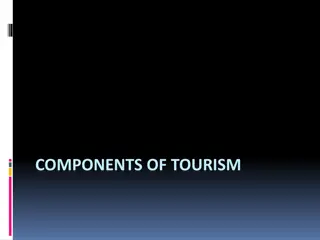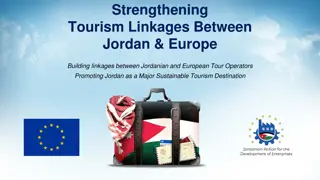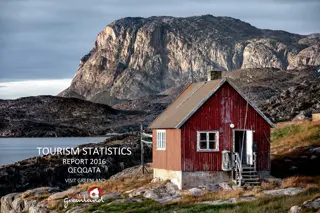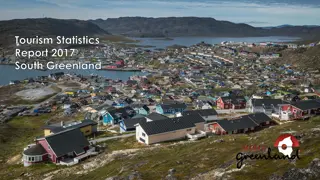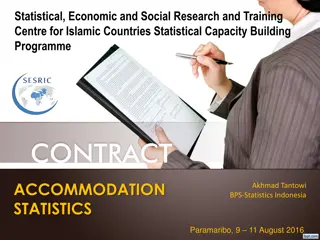Impact Assessment in Events and Tourism: Models and Applications
This text discusses various models and applications of Impact Assessment (IA) in events and tourism, exploring topics such as strategic impact assessment, economic, social, and cultural impacts, and performance evaluation. It covers the subjects and objects of IA, forecasting impacts, and the outcomes model. The content emphasizes the importance of evaluating the impacts of events and tourism on the economy, society, and environment, and highlights the need for controllable indicators and performance management arrangements.
Download Presentation

Please find below an Image/Link to download the presentation.
The content on the website is provided AS IS for your information and personal use only. It may not be sold, licensed, or shared on other websites without obtaining consent from the author. Download presentation by click this link. If you encounter any issues during the download, it is possible that the publisher has removed the file from their server.
E N D
Presentation Transcript
EVENT IMPACT ASSESSMENT Donald Getz, 2018 Figure 1.5 Four Applications of IA for Events and Tourism Figure 1.7: The Subjects and Objects of Impact Assessment Figure 2.1: Outcomes System Model Adapted From Duignan Figure 2.2: Logic Model for Event and Tourism Evaluation and Impact Assessment Figure 2.3: Theory of Change Model Figure 2.5: The Forces-Pressure-State-Impact-Response Model Figure 3.6: Sample Decision Tree Figure 4.5: Indicators for Measuring the Social-Capital Outcomes of Events Figure 5.2: Mind Mapping for Consultations in CIA Figure 7.1: Event Settings Spectrum and Key Impact Variables Figure 8.4: The Direct and Indirect Contribution of Event Tourism Figure 9.2: The BACE MODEL
FORECASTING IMPACTS -What impacts will occur if we take a specified action? POST-EVENT IA -What were the demonstrable outputs and impacts of a planned event or a tourism project? IA OF EVENTS/TOURISM ON THE ECONOMY, SOCIETY OR ENVIRONMENT -What have been the overall impacts of events and/or tourism on the economy, society or environment? STRATEGIC IMPACT ASSESSMENT: what are the probable impacts of alternative policies, strategies or programmes?
IA OBJECTS THE SUBJECTS OF IA: ECONOMIC IMPACTS Individuals & Families (Residents) Groups & Sub Cultures ECOLOGICAL IMPACTS Events & Event Organisations Communities and Cities Businesses TOURISM AND EVENTS AS AGENTS OF CHANGE SOCIAL IMPACTS Tourist Destinations CULTURAL IMPACTS Politics & Government Society; The Nation BUILT- ENVIRONMENT IMPACTS
OUTCOMES MODEL Logic models or theory of change models that specify high- level desired outcomes (i.e., priorities) and actions necessary to attain them. Use theory or past experience that suggests how to attain goals. CONTRACTING, ACCOUNTABILITY AND PERFORMANCE MANAGEMENT ARRANGEMENTS CONTROLLABLE INDICATORS (Key Impact Indicators that show outcomes have been caused by the event or project) Stakeholders must agree on goals, methods and measures for IA and evaluation. NOT NECESSARILY CONTROLLABLE INDICATORS (these also suggest goal attainment, but might be partly or wholly due to uncontrollable external forces. What evidence of goal attainment (outcomes) will be acceptable? IMPACT EVALUATION ATTRIBUTING CHANGE (The IA process) ECONOMIC & COMPARATIVE EVALUATION (e.g., Comparing ROI of alternatives) PERFORMANCE IMPROVEMENT EVALUATION -e.g. service and programme quality Adapted from: Duignan, P. "Using outcomes theory to solve important conceptual and practical problems in evaluation, monitoring and performance management systems." American Evaluation Association Conference, Orlando, Florida, 11 14 November 2009.
Single events do not usually pursue enduring change Process for Single Events EXPECTED OUTPUTS INPUTS PLANNED ACTIONS -mandate PURPOSE & GOALS DESIRED IMPACTS; CHANGE -e.g. -resources (the event as a transforming process) attendance, tourists, money raised, satisfaction -venues -information Special Concerns for Event-Tourism Portfolios Portfolio Strategy; Long-term Investment -Overall ROI -Sustainability -Integration with other policy fields -Bidding (one-time events) -Owning/producing -Supporting events -Growth in tourism yield -Leveraging effects -Economic and community growth -Competitive advantages
INTENDED OUTCOMES: -social inclusion and integration External Factors: -other social programmes -economic and demographic trends -other events OUTPUTS (short-term indicators of progress) -attendance -participation by all stakeholders -satisfaction of attendees -money raised -skills / learning demonstrated -perception of success -future intention to proceed with plan Key Impact Indicators: -perceived quality of life improved, for all stakeholder groups -reduced hate crimes -increased capacity for self-direction and community development ACTIONS NEEDED (Causal Pathways) -participatory planning and production of event -skills training -education and discourse among groups -raising money for causes -outreach into communities Assumptions: -The need exists -Festivals play a role PRECONDITIONS -stakeholder engagement and support -inputs (resources available)
DRIVING FORCES -event legitimation -event portfolio policies/strategies RESPONSE OPTIONS PRESSURE The cycle is dynamic, as responses lead to new pressures -accept the changes -venue development -cancellation of event or project -events & -select other alternatives event tourism -mitigation -media coverage -compensation IMPACT STATE -changes in the environment, economy, society and culture that are attributable to events and tourism -existing environmental, social, cultural economic conditions
Forecasts of Goal Attainment (P = the estimated probability) Three options for a new event with multiple goals Maximises monetary ROI and tourism yield P = 100% ALTERNATIVE 1: Maximises community engagement P = 80% DECISIONS BASED ON IMPACT FORECASTING ALTERNATIVE 2: P = 90% Maximises publicity and image enhancement P = 50% ??? ALTERNATIVE 3: Minimises Community Disruption P = 75 %
COGNITIVE STRUCTURAL DIMENSION RELATIONAL DIMENSION DIMENSION NORMS AND VALUES SOCIAL COHESION TRUST -shared emotional links (communitas) -social interaction -degree of trust between individuals and groups and how these are manifested -neighbourhood cohesion -collective goals -togetherness -mutual support -affective bonds CIVIC ENGAGEMENT TRUST SOCIAL NETWORKS -number of volunteers, level of commitment, where they come from -interpersonal -bonding, bridging and linking relationships -reciprocity -participation in community actions and politics NETWORK STRUCTURE -diversity, density, size & formality of inter-group collaboration
-More traffic in neighbourhood -New commercial cluster formed with permanent land-use changes that will impact on daily life BUILT ENVIRONMENT IMPACTS CULTURAL IMPACTS -are there potential benefits or negative impacts to your distinctive culture & heritage? ECONOMIC IMPACTS PROPOSED MAJOR EVENT VENUE PERCEIVED IMMEDIATE SOCIAL/CULTURAL IMPACTS: -daily routines altered -increased incomes -population growth -less contact with nature -more leisure opportunities -noise and safety concerns PERCEIVED LONGER-TERM EFFECTS -demographic shifts owing to in-migration -threats to traditions and language -possible diminished quality of life -hopeful of improvement in services for health, education, leisure -Temporary and permanent jobs created -Many future events and an increase in tourism -Increase in carbon emissions/pollution -Permanent land use changes with effects on parkland and wildlife. SOCIAL IMPACTS -are there potential benefits or negative impacts on your quality of life? ECOLOGICAL IMPACTS
IMPACT VARIABLES: -construction needed/allowed -permanent infrastructure available -accessibility; public transit -sensitivity; protected status -attendance limits; capacity -use/activity restrictions; -management systems in place (e.g. RRR) -residential context (high density or none) OUTDOORS -nothing built; temporary infrastructure only INDOOR VENUES -management systems in place for events INCREASINGY URBAN INCREASINGLY NATURAL -natural areas with some event Infrastructure; limited development -wilderness areas hosting occasional events; no permanent development or changes allowed -convention & exhibition centres -theatres; concert halls -galleries; museums -schools; community centres -city streets & parks used occasionally for events -rural event sites with some permanent infrastructure
NEW MONEY or incrementalincome from event tourists, sponsors, grants etc., when attributable to the event Increased consumer spending in area BACKWARD LINKAGES: Using local suppliers & workers INDIRECT or SECONDARY IMPACTS DIRECT ECONOMIC CONTRIBUTION INDUCED or TERTIARY IMPACTS LEAKAGES: Imports: money spent outside area by suppliers and workers LEAKAGES: Money spent outside the area by organizers LEAKAGES: Imports to satisfy local consumer demand
BACE: BENEFITS AND COSTS EVALUATION STRATEGY & GOALS: EVALUATION & IA PROCESS: Feedback: Continuous Improvement BENEFITS (OUTCOMES / IMPACTS) TO BE ATTAINED KEY PEFORMANCE INDICATORS FOR EVALUATION AND KEY IMPACT INDICATORS FOR IMPACT ASSESSMENT LOGIC & THEORY OF CHANGE MODELS: HOW EXACTLY ARE BENEFITS / IMPACTS TO BE GENERATED? COSTS AND RISKS COSTS AND NEGATIVE IMPACTS TOBE AVOIDED OPPORTUNITY COSTS; UNCERTAINTY; DISTRIBUTION OF COSTS VS. BENEFITS AND /OR MITIGATED Impact Assessment & Evaluation Methods & Issues: Comprehensiveness; Appropriate Evidence; Principles of Sustainability & Responsibility; Value Perspectives; Transparency and Accountability



